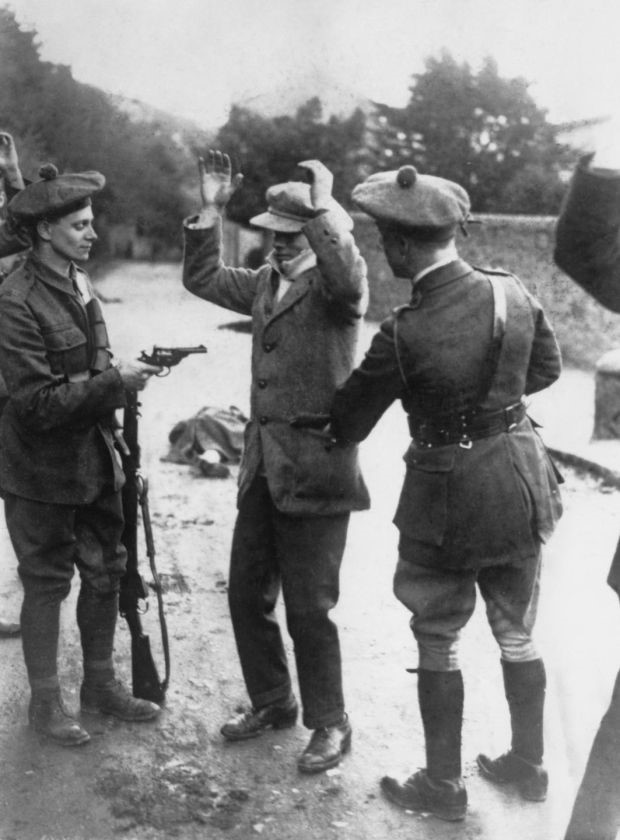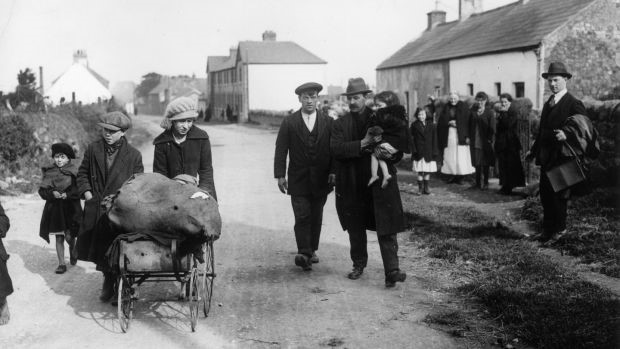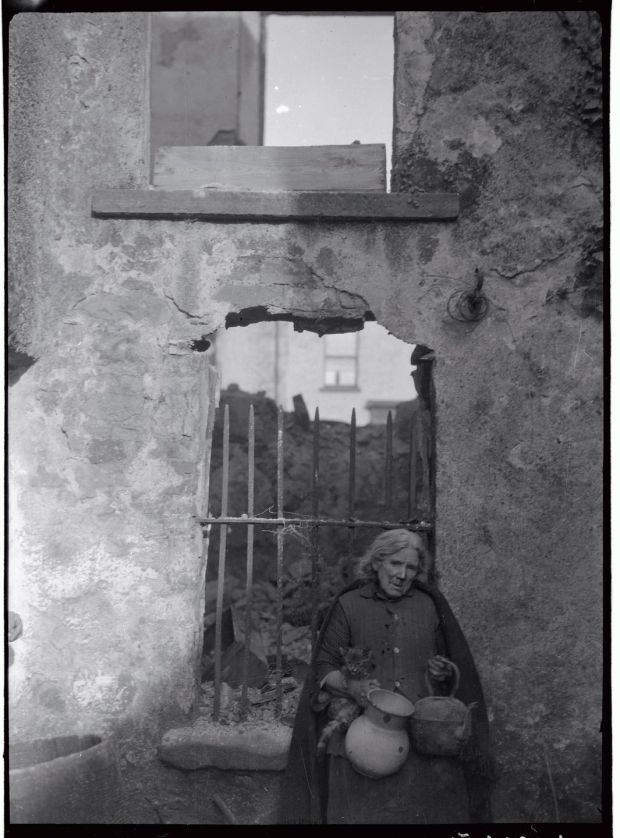Black and Tans: “Half-drunk, whole-mad” and one-fifth Irish
Posted By: January 11, 2020
Diarmaid Ferriter: The terrorizing Black and Tans had no monopoly on brutality in 1920
Diarmaid Ferriter. Irish Times. Dublin. Saturday, January 4, 2020
(Diarmaid Ferriter is Professor of Modern Irish History at UCD and an Irish Times columnist)
Black & Tans guarding Dublin street after a shooting on Gloucester Road.
One of the striking developments of 1919 in Ireland was the extent to which the Royal Irish Constabulary (RIC), policing Ireland since 1836, came under siege by the IRA and was increasingly ostracized by the communities it served.
Diarmuid O’Hegarty, the director of communications for the IRA, left no room for ambiguity when he composed a memorandum that year on what the targeting of the RIC should amount to: “the police should be treated as persons who having been adjudged guilty of treason to their country are regarded as unworthy to enjoy any of the privileges or comforts which arise from cordial relations with the public”.
In December 1919, the RIC inspector general reported that his policemen “were not strong enough to cope but for the assistance of the military”. The RIC men were ill-equipped to deal with guerrilla warfare and were easy targets, as were their barracks which were being burnt out and evacuated in considerable numbers.
But British counter-insurgency policy held that the RIC’s place was still in the front line. British prime minister David George’s government was adamant that counter-insurgency was “a policeman’s job”; part of a wider refusal to acknowledge there was a war going on in Ireland.
Notwithstanding, the pressure on the RIC had prompted talk in Dublin Castle in the second half of 1919 of augmenting the force with a new group of ex-soldiers. Authority was given by the government for such an initiative in November 1919 and the first soldiers were recruited 100 years ago this month, at a time when Lord French, the Lord Lieutenant of Ireland, admitted to Ian MacPherson, the Chief Secretary of Ireland: “matters here are really getting beyond the control of the police”.
A shortage of uniforms led to them wearing a mixture of police and military clothing… earning the moniker Black and Tans
The British advertisement seeking recruits asked “DO YOU WANT A JOB? YOU CAN JOIN THE RIC: THE FINEST CONSTABULARY FORCE IN THE WORLD”.
Terms of service included pay of 10 shillings a day, a month’s fully paid leave every year and “pensions on the highest scale payable to any police force in the UK… if you have the Physique – if you have a Good Character, And especially – if you are an Ex-Service Man YOU CAN JOIN THE RIC TODAY”.
A shortage of uniforms led to them wearing a mixture of police and military clothing; elements of the darker police uniform with the khaki, earning the moniker Black and Tans, which was also possibly a reference to a famous pack of foxhounds in Co Limerick.
The first Black and Tans arrived in March 1920 where they received cursory training at a depot in the Phoenix Park; subsequent recruits were trained at Gormanstown. There was a surge in recruitment later in 1920 as the British economy struggled, with more than 1,100 recruits joining the force in October 1920 alone. Eventually, over 8,000 of them were to serve in Ireland and most were sent to Cork, Tipperary, Galway, Clare, Limerick, and Kerry
Who joined the Black and Tans and why did they become notorious? Canadian historian David Leeson, author of The Black and Tans (2011), which draws on British records, makes it clear they were recruited too quickly, without proper training or assessment of suitability and encouraged to treat republicans as they wished.
But it was not the case, as often contended by Irish republicans, that they were “largely drawn from the criminal classes”. Rather they were a collection of British and Irish ex-servicemen, very few of whom had criminal records.
They were mostly young, unmarried, Protestant working-class men; the majority were unskilled or semi-skilled workers (52 percent) and skilled manual workers (36 percent) made up most of the rest. The relatively high rates of pay were a draw at £3 10 shillings a week, with allowances.
Those Black and Tans who had been hardened by the first World War service had no monopoly on brutality; their fellow recruits with pre-war service were also likely to act with impunity and indiscipline.
- Commemoration controversy: Who were the RIC, DMP, Black and Tans, and Auxiliaries?
- State to mark Cork’s pivotal role during War of Independence
A suspected member of Sinn Féin is searched at gunpoint by temporary constables of the Black and Tans in November 1920. Photograph: Topical Press Agency/Hulton Archive/Getty Images
Leeson underlines the poor conditions in which they lived, billeted in police barracks. The IRA’s ability to choose and vary ambush sites left them physically and psychologically vulnerable and casualty rates were high; Leeson gives figures of 42 percent wounded and 24 percent killed.
It is estimated that almost 20 percent of them were Irish-born. Historian William Lowe’s examination of the recruitment registers of 2,300 Black and Tans reveals that one third were recruited in London, over one third in Liverpool and Glasgow and 14 percent in Dublin. This was an overwhelmingly English force – 78.6 percent of Lowe’s sample – but 19 percent of the sample were Irish born and their average age was 26½.
One recruit who was subsequently to resign recalled “we were mercenary soldiers fighting for our pay, not patriots willing and anxious to die for our country… Our job was to earn our pay by suppressing the armed rebellion, not die in some foolish… forlorn hope.”
Another, Douglas Duff, who wrote a memoir, remembered that “it had not been hard to join” and that he was sent to Dublin the same day he was sworn in.
The Black and Tans had a deserved reputation for brutality; they were not trained as policemen, were regarded as “gun-happy” and were ill-disciplined.
They terrified the inhabitants of Balbriggan in Dublin, for example, with a “sacking” of the town in September 1920 in revenge for the murder of a RIC district inspector and his brother. They burned and destroyed homes and businesses and beat two Republicans to death. As was well recognized at the time, the “majority of those attacked were victims innocent of any documented complicity.”
September 1920: Refugees leaving Balbriggan, Co Dublin, the scene of violent reprisals by Black and Tans following the murder of Head Constable Burke of the Royal Irish Constabulary. Photograph: Topical Press Agency/Getty Images
The War of Independence intensified as 1920 progressed; it became more brutal, and an increasingly ruthless IRA saw it as necessary to provoke publicity and international sympathy. Historian of the War of Independence, Michael Hopkinson, sees the Black and Tans as “effect rather than cause; however appalling their deeds, they were the product of Lloyd George’s policies” and he quotes from an article in May 1921 by Violet Asquith, a Liberal activist, and daughter of the former prime minister Herbert: “We have to feel sorry for the Black and Tans… losing their souls in carrying out duties which no Englishman should have been asked to perform”.
What those “duties” meant in Ireland, notes Hopkinson, was that “the list of reprisals in the late summer and autumn of 1920 reads like a somber catalog of small towns throughout the length and breadth of the south and west”. Revenge attacks, authorized and unauthorized, did damage to Britain’s reputation. As the Observer put it in September 1920, they contributed to “the immense weakening of Britain’s moral position throughout the world.”
Playwright Lady Gregory wrote reports on the activities of the Black and Tans around Coole in Galway, where she resided, under the title “A week in Ireland” for The Nation in London, though they were not published under her name. She also referred to them in her journals and depicted them as a “terrible class… the standard reduced, little chaps of 5 foot 6 and with no character”.
Beatings, hair cuttings and worse… which included women in night attire being assaulted by drunken Black and Tans
In Gort in December 1920, as observed by historian Roy Foster, “a new level was plumbed” when two local boys with no IRA connections were murdered by the Black and Tans for “impudence”. Their bodies were thrown into a ditch “after being dragged behind one of the dreaded lorries until they were unrecognizably mangled”. This was just one example of what poet WB Yeats referred to in his poem Reprisals as “Half-drunk or whole-mad soldiery”.
Although both the Black and Tans and the Auxiliaries became associated with terror, reprisals and extra-judicial killings, including on Bloody Sunday in Croke Park in November 1920, and frequently worked in collaboration, it is important to distinguish between them, as they were separate forces. Raised from among demobilized officers of the British army, the Auxiliaries were recruited from July 1920 in response to the escalation of the conflict.
While both groups were there to reinforce the RIC, the Auxiliaries were a much smaller group, intended to be an elite cadre or strike force, and was only nominally under RIC command. The Auxiliaries were not “guns for hire” and never numbered more than 2,263. They were also paid much better – £7 a week – than the Black and Tans
It was the impact on civilians that hardened opinion against them and secured the Black and Tans’ legacy. WB Yeats’s sister Lily wrote to her father John in December 1920 that after witnessing months of Black and Tan atrocities and having seen a lorryload of them pass her house with “Reprisals Galore” scrawled on the side, her political stance changed: “As you know I was no Sinn Féiner a year ago, just a mild nationalist – but now…”
As documented by historian Louise Ryan, in the context of a guerrilla war in rural Ireland in isolated areas, women at home were easy targets for the Black and Tans. A report of the American Commission on Conditions in Ireland gave evidence in 1920 of the frequency with which “the sanctity of the family home is violated”.
As documented by historian Louise Ryan, in the context of a guerrilla war in rural Ireland in isolated areas, women at home were easy targets for the Black and Tans
Beatings, hair cuttings and worse were described in contemporary newspapers under the catchall label “Outrages”, which included women in night attire being assaulted by drunken Black and Tans. Sexual assaults were occasionally recorded by Sinn Féin’s The Irish Bulletin and as Ryan notes: “Images of the drunken Tan emphasized the worst extremes of British masculinity; by contrast, sobriety, courage, and chivalry towards women were the self-ascribed characteristics of Irish republican masculinity”.
Harassment by the Black and Tans took other forms. John Duffy, an RIC member, recalled that “it was a common practice for them, when they went out the country in their lorries, to shoot down fowl and other poultry, the property of poor people, and bring them back to the mess where some of them were cooked for their own use and those that were not required were dispatched to their families in England’.
Many in the RIC strongly resented the coming of the Black and Tans, whom they regarded as morally and professionally reprehensible – “they’d have shot their mother”, according to one witness – and reactions to them can be traced through the Bureau of Military History statements taken in the 1940s and 1950s.
Jeremiah Mee, instigator of a mutiny within the Listowel RIC against the taking over of their barracks by the British military, explained the sentiments behind the mutiny: “When we joined the police force, we joined with characters second to none and we refused to co-operate or work in any capacity with the British military, men of low moral character who frequented bad houses, kept the company of prostitutes and generally were unsuitable and undesirable characters”.
John Flannery, one of the participants in the Mutiny of the Connaught Rangers in India in 1920, when a company of the Rangers stationed at Jullundur on the plains of Punjab refused to perform their military duties as a protest against British military activity in Ireland, insisted that the mutineers’ action was prompted by the treatment of their mothers and sisters by the Black and Tans.
The mutineers’ spokesman “put it to the general if it was a fitting reward for the sacrifices that thousands of Irishmen had made on many fronts throughout the Great War and to these men on parade who came through this great ordeal, to return home and learn that our own fellow countrymen and women were being shot down by the orders of the British government”.
Such was the cementing of the notorious reputation of the force that the war of independence was often referred to as “the Tan war”. But regular RIC members also became capable of brutality and reprisals, as did the IRA, such was the nature of the war.
Well known Tipperary IRA volunteer Dan Breen was not shy of exaggeration in his memoir, but it is difficult to dispute the accuracy of his assertion that “the words Black and Tans have become a symbol of terrorism”.
They were far from the only symbol of terror in Ireland in 1920, but their impact on civilians, in particular, led to them occupying an elevated position in the hierarchy of villains of that period of Irish history. Theirs was a dismal record, reflecting very poorly on their political creators.
Diarmaid Ferriter is Professor of Modern Irish History at UCD and an Irish Times columnist














